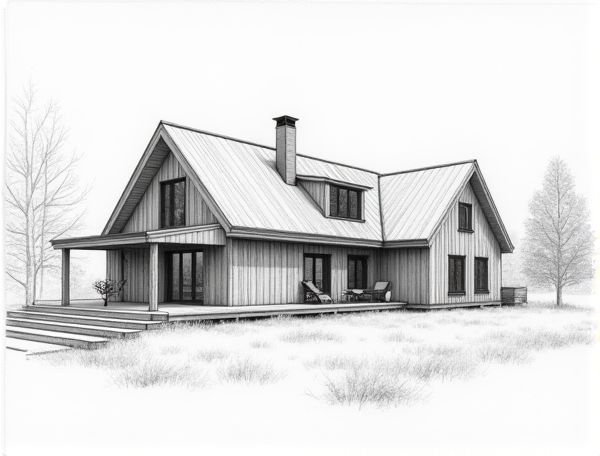
Photo illustration: Scandinavian home design with passive solar heating
Scandinavian home design prioritizes simplicity, natural materials, and light-filled spaces, seamlessly integrating passive solar heating to enhance energy efficiency and indoor comfort. Discover how incorporating these principles can transform your living environment by reading more in the article.
Introduction to Scandinavian Home Design
Scandinavian home design emphasizes simplicity, functionality, and minimalism, featuring clean lines, natural materials such as wood and leather, and a neutral color palette dominated by whites, grays, and soft pastels. This design style prioritizes light-filled spaces, cozy textiles, and decluttered interiors to create an inviting and serene atmosphere.
Core Principles of Passive Solar Heating
Core principles of passive solar heating include maximizing south-facing window exposure to capture sunlight while using thermal mass materials such as concrete or brick to store and gradually release heat. Your home design should also incorporate proper insulation, air sealing, and shading techniques to regulate indoor temperature and improve energy efficiency.
Integrating Nordic Minimalism with Energy Efficiency
Nordic minimalism emphasizes clean lines, natural materials, and functional design, which seamlessly complement energy-efficient home features like high-performance insulation and triple-glazed windows. By incorporating these elements, your home achieves both aesthetic simplicity and reduced energy consumption, enhancing comfort while lowering utility costs.
Essential Architectural Features for Solar Gains
Optimal solar gains in home design rely on strategically placed south-facing windows that maximize natural light and heat during winter months. Incorporating thermal mass materials such as concrete or brick helps absorb and store solar energy, releasing it slowly to maintain indoor warmth. Proper roof overhangs provide shade in summer while allowing low-angle winter sun to penetrate, enhancing energy efficiency and comfort.
Optimal Window Placement in Scandinavian Homes
Optimal window placement in Scandinavian homes maximizes natural light and enhances energy efficiency by strategically positioning windows to capture the low-angle sunlight typical in northern latitudes. Large, triple-glazed windows are often used to reduce heat loss while maintaining a strong connection to the natural surroundings, creating a bright and inviting interior. Your design can benefit from aligning windows with key sightlines and prevailing sun paths to improve indoor comfort and aesthetic appeal throughout the year.
Thermal Mass Materials for Heat Retention
Thermal mass materials like concrete, brick, and stone absorb and store heat during the day, releasing it slowly at night to maintain stable indoor temperatures. Utilizing these materials in home design enhances energy efficiency by reducing the need for artificial heating and cooling.
Insulation Techniques for Harsh Climates
Effective insulation techniques for harsh climates include using spray foam insulation, rigid foam boards, and cellulose to enhance thermal resistance and prevent heat transfer. Installing vapor barriers and sealing air leaks around windows and doors further improves energy efficiency and indoor comfort in extreme weather conditions.
Sustainable Building Materials in Scandinavia
Sustainable building materials in Scandinavia include cross-laminated timber (CLT), which offers carbon sequestration and renewability benefits. The region emphasizes the use of locally sourced wood, hempcrete, and recycled steel to minimize environmental impact and promote energy efficiency. Scandinavian architects prioritize eco-friendly insulation materials such as cellulose and sheep wool to enhance thermal performance while reducing carbon footprints.
Combining Aesthetics with Eco-Friendly Solutions
Integrating sustainable materials such as bamboo flooring and recycled glass countertops enhances visual appeal while minimizing environmental impact. Employing energy-efficient lighting and smart home systems further optimizes resource conservation without compromising design elegance.
Case Studies: Passive Solar Scandinavian Homes
Passive solar Scandinavian homes utilize strategic window placement and high thermal mass materials to maximize solar heat gain during winter while minimizing heat loss. Case studies reveal energy savings of up to 40% compared to conventional designs, highlighting the effectiveness of triple-glazed windows, super-insulation, and airtight construction in cold climates.
 homedesy.com
homedesy.com